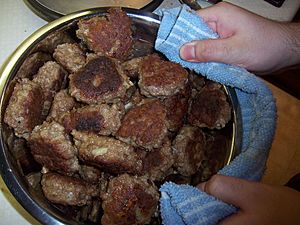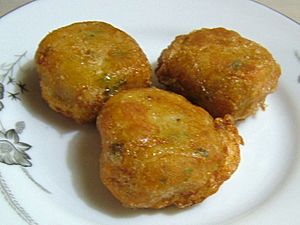Frikadelle facts for kids

A freshly made batch of Frikadellen
|
|
| Place of origin | Uncertain; supposedly Denmark or Germany |
|---|---|
| Serving temperature | Hot or cold |
| Main ingredients | Pork, veal, lamb, beef or fish |
| Other information | Generally served with boiled potatoes with gravy, or creamed cabbage |
A frikadelle is a rounded, flat-bottomed, pan-fried meatball of minced meat, often likened to the German and/or Danish version of meatballs. The origin of the dish is unknown. The term frikadelle is German but the dish is associated with German, Scandinavian and Polish cuisines. They are one of the most popular meals in Poland, they are known as kotlety mielone.
There are various local variants of frikadelle throughout Scandinavia, as both a main course and a side dish. In Sweden, the word frikadeller refers to meatballs that are boiled, not pan-fried.
Contents
Etymology
The origin of the word is uncertain. According to the Etymologisches Wörterbuch des Deutschen, Frikadelle (pl. Frikadellen) can be found end of the 17th century in German, and is related to the French fricandeau, and Latin frīgere ('to roast'). Other variants used in Germany are Boulette/Bulette, Bratklops, Fleischpflanzerl, Fleischlaberl, Fleischküchle and Grillette/Grilletta as well as the Austrian Faschiertes Laibchen. It may be derived from fricandeau de veau, a dish of sliced veal, larded with pork fat. In the Dictionnaire des dictionnaires (1837) fricadelle is defined as, "In Belgium, a ball of minced, cooked meat" and a separate word, fricadèle, is defined as fricandeau. And in Phillips's New World of Words (1706) it is defined as "Fricandoe, a sort of Scotch Collops made of thin slices of Veal, well larded and stuff'd." The Oxford English Dictionary defines fricandele (variation fricadelle) as a "quasi-French form of fricandeau".
Other variations
Denmark
In Denmark, traditionally, they are made from minced veal, pork or beef (or a blend of two of these meats); chopped onions; eggs; milk (or water); bread crumbs (or oatmeal or flour); salt; and pepper; then formed into balls by using a tablespoon to get the right size frikadelle and flattened somewhat. They are then pan-fried in pork fat or beef fat, or more commonly in modern times in butter, margarine or even vegetable oil. Another popular variation is fiskefrikadeller replacing the meat with fish (mostly cod, but sometimes cod and salmon) as the main ingredient and often served with remoulade.
As a main dish, they are most often served with boiled white potatoes and gravy (brun sovs) accompanied by pickled beetroot or cooked red cabbage. Alternatively, they can be served with creamed, white cabbage.
Frikadeller are also eaten on ryebread (rugbrød) with red cabbage or pickle slices as a traditional Danish smørrebrød.
The combination of frikadeller and a cold potato salad is very popular at picnics or potlucks, due to the ease of transporting either component after cooking.
Indonesia
Frikadel are also known in Indonesian cuisine through Dutch cuisine (of the frikadel, which is historically similar to the frikadaller) influence and called perkedel, however the main ingredient is not meat, but mashed potato, sometimes slightly mixed with ground meat or corned beef. The mixture is then shaped into flat round patties and dipped in egg yolk before being deep fried. Other than mashed potato, cabe rawit, spring onion, shrimp, peeled corn, or mashed tofu fritters are also common as perkedel ingredients.
See also
 In Spanish: Frikadeller para niños
In Spanish: Frikadeller para niños
- Frikkadel
- Frikandel
- Hamburg steak
- Hamburger
- Shami kebab
- List of meatball dishes
- Perkedel
- Cuisine of Denmark
- Cuisine of Germany
- Cuisine of Norway
- Salisbury steak
- South African cuisine
- Skilpadjies
- Swedish meatball
- Dry meatballs
- Tteok-galbi


